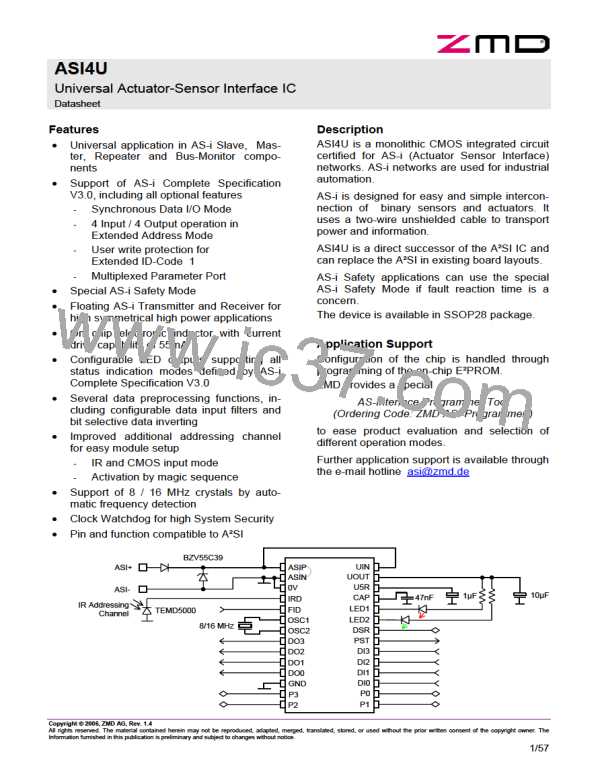ZENTRUM MIKROELEKTRONIK DRESDEN AG
“ASI for you” IC
Datasheet
3.17.2 Input Impedance (AS-i bus load)
The following parameters are determined with short cut between the pins ASIP and UIN and the pins ASIN and
0V, respectively.
Table 34: AS-i Bus Load Properties
Symbol Parameter
Min
13,5
13,5
Max
30
Unit Note
1,2
RIN1
LIN1
Equivalent resistor of the IC
kΩ
1,2
Equivalent inductor of the IC
Equivalent capacitor of the IC
Equivalent resistor of the IC
Equivalent inductor of the IC
Equivalent capacitor of the IC
mH
1,2
CIN1
RIN2
LIN2
pF
1,2
13,5
12
kΩ
1,2
13,5
mH
1,2
CIN2
CZener
15 + (L-12mH)*10pF/mH
20
pF
1
Parasitic capacitance of the external
over-voltage protection diode (Zener
diode)
pF
1 The equivalent circuit of a slave, which is calculated from the impedance of the IC and the paralleled external
over-voltage protection diode (Zener diode), has to satisfy the requirements of the AS-i Complete Specification
for Extended Address Mode slaves.
2 Subtracting the maximum parasitic capacitance of the external over voltage protection diode (20pF) either the
triple RIN1, LIN1 and CIN1 or the triple RIN2, LIN2 and CIN2 has to be reached by the IC to fulfill the AS-i Complete
Specification.
Table 35: CAP pin parameters
Symbol Parameter
Min
-0.3
Typ
47
Max
VU5R
Unit Note
VCAP_IN Input voltage range
V
CCAP
External decoupling capacitor
nF
Note: In some application a serial to CCAP connected resistor may enhance the impedance behavior of the
internal electronic inductor. Depending of the application this resistor has to be dimensioned between
10 … 100Ω .
The decoupling capacitor defines an internal low-pass filter time constant; lower values decrease the
impedance but improve the turn-on time. Higher values do not improve the impedance but do increase
the turn-on time.
The turn-on time also depends on the load capacitor at UOUT. After connecting the slave to the power
the capacitor is charged with the maximum current IUOUT. The impedance will increase when the voltage
allows the analog circuitry to fully operate.
3.18 Thermal and Overload Protection
The IC continuously observes its silicon die temperature. If the temperature rises above around 140°C for more
than 2 seconds the IC will be put into shutdown and stay there until the next power-on reset occurs.
The circuit also becomes shut down if UOUT is overloaded (e.g. shorted to GND) for more than 2 seconds.
Table 36: Shutdown Temperature
Symbol Parameter
Min
125
Max
160
Unit
°C
Note
TShut
Chip temperature for over temperature shut down
Copyright © 2006, ZMD AG, Rev.1.4
All rights reserved. The material contained herein may not be reproduced, adapted, merged, translated, stored, or used without the prior written consent of the copyright owner. The
Information furnished in this publication is preliminary and subject to changes without notice.
50/57

 ZMD [ Zentrum Mikroelektronik Dresden AG ]
ZMD [ Zentrum Mikroelektronik Dresden AG ]